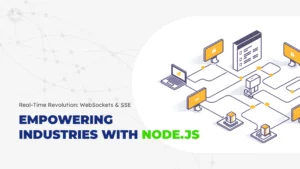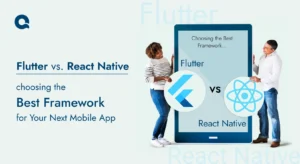
Building a startup is akin to constructing a house: a solid foundation is paramount. Adopting a cloud-first strategy provides this foundation, allowing startups to deploy resources swiftly without the overhead of physical servers. This approach enables teams to concentrate on product development rather than infrastructure management. For instance, Notion began with a single PostgreSQL database and scaled it as their user base expanded.
In this article, we’ll delve into the principles of a cloud-first, fail-less architecture, covering topics from MVP infrastructure to scaling strategies, tech stack choices, and more. We’ll also highlight real-world examples, including insights from QalbIT, a company specializing in custom software development for startups.
What is a Cloud-First Strategy?
A cloud-first strategy involves prioritizing cloud services—such as IaaS, PaaS, and SaaS—for all development and production needs. Instead of investing in physical servers, startups leverage cloud platforms like AWS Activate, Google Cloud for Startups, or Azure for Startups to provision virtual machines, containers, or serverless functions.
Benefits:
- Speed & Agility: Rapid deployment of resources without hardware constraints.
- Cost Efficiency: Pay-as-you-go models reduce upfront costs. Programs like AWS Activate and Google Cloud’s Startup Program offer substantial credits to new startups.
- Global Reach: Deploy applications across multiple regions to serve a global user base and comply with local regulations.
Geographical Context:
- United States: High cloud maturity with extensive ecosystem support.
- India: Emphasis on lean operations and rapid MVP development.
- UAE: Government initiatives are accelerating cloud adoption in emerging markets.
Designing a Fail-Less Architecture
A fail-less architecture doesn’t imply zero failures but emphasizes resilience and graceful degradation. Key principles include:
- Redundancy: Duplicate critical components to eliminate single points of failure.
- Load Balancing: Distribute traffic to prevent overloading any single resource.
- Auto-Scaling: Automatically adjust resources based on demand.
- Decoupling & Circuit Breakers: Isolate services to prevent cascading failures.
- Monitoring & Self-Healing: Implement health checks and automated recovery mechanisms.
- Chaos Testing: Inspired by Netflix’s Chaos Monkey.
Utilizing managed services from cloud providers can simplify the implementation of these principles.
From MVP to Scale
Starting with a Minimum Viable Product (MVP) allows startups to validate ideas quickly. However, it’s crucial to design the MVP with scalability in mind.
Strategies:
- Measure and Refine: Use Application Performance Monitoring (APM) tools to spot bottlenecks.
- Incremental Upgrades: Enhance components as needed without overhauling the entire system.
- Add Features Judiciously: Avoid unnecessary complexity; implement microservices only when beneficial.
- Leverage Managed Services: Utilize services like managed databases and authentication to reduce operational overhead. Use Firebase, Auth0, and Stripe.
👉 For a deep dive into MVP planning and tech choices, read our Custom Software Development for Startups – 2025 Guide.
Selecting the Right Tech Stack
Choosing an appropriate tech stack is critical for scalability and maintainability.
Considerations:
- Languages & Frameworks: Select based on team expertise and project requirements.
- Frontend Frameworks: Assess the popularity and community support of React, Vue, and Angular. Compare React vs Vue vs Angular.
- Backend & APIs: Design RESTful or GraphQL APIs for flexibility.
- Databases: Choose between SQL and NoSQL based on data structure and scalability needs.
- DevOps & Cloud Services: Implement CI/CD pipelines and infrastructure as code for efficient deployments.
- Security & Compliance: Ensure adherence to best practices and regulatory requirements.
Pick what lets your team move fast without compromising long-term scalability. Choosing frameworks and patterns that support clean architecture principles—like separation of concerns and modular design—helps your application remain adaptable as it scales.
Microservices vs. Monolith
The debate between microservices and monolithic architectures centers on scalability and complexity.
- Monolithic: Simpler to develop and deploy initially but can become unwieldy as the application grows.
- Microservices: Allow independent scaling and deployment of services but introduce complexity in communication and management.
Only build new architecture (like microservices) when you actually need it. Premature complexity is dangerous, but following clean architecture from the start can help you add features later without introducing technical debt. Check QalbIT’s guide on Microservices vs Monolithic.
Real Startup Examples
- Notion: Scaled a monolithic architecture by sharding its database to handle increased load.
- Figma: Implemented vertical partitioning to manage data growth before moving to a distributed system.
- Zapier: Utilized a combination of monolithic and serverless architectures to process billions of tasks efficiently.
- QalbIT: Assists startups in designing MVPs and scaling them using cloud-first best practices.
Budgeting for Infrastructure
Effective budgeting ensures sustainable growth.
Tips:
- Utilize Cloud Credits: Take advantage of startup programs offering free credits.
- Monitor Usage: Implement tools to track and optimize resource consumption.
- Automate Operations: Use automation to reduce the need for extensive DevOps personnel.
- Regional Considerations: Adjust strategies based on local costs and regulations.
Scalable Infrastructure Checklist
Design for Growth: Plan for scalability from the outset.
Leverage Managed Services: Utilize cloud offerings to reduce operational complexity.
Start Monolithic, Evolve as Needed: Begin with a simple architecture and refactor when necessary.
Implement Redundancy: Ensure high availability through duplication.
Optimize Database Access: Use caching and indexing to improve performance.
Use Infrastructure as Code: Maintain consistency across environments.
Monitor Everything: Set up comprehensive monitoring and alerting.
Ensure Security and Compliance: Adhere to best practices and legal requirements.
Control Budget: Regularly review and adjust spending.
Iterate and Refine: Continuously improve based on feedback and metrics.
Conclusion
Adopting a cloud-first strategy and designing a fail-less architecture are pivotal for startups aiming to scale efficiently. By learning from industry examples and leveraging the expertise of partners like QalbIT, startups can navigate the complexities of infrastructure development and focus on delivering value to their users.
👉 Want expert help building cloud-native MVPs and scaling seamlessly?
Visit QalbIT’s Blog or explore our custom software services. Wondering how much does custom software development cost for your MVP? Check out our cost breakdown guide or get a free quote from our team.
Frequently asked questions
A cloud-first strategy involves prioritizing cloud services for all operations, offering scalability, cost savings, and rapid deployment, which are essential for startups.
Implement redundancy, load balancing, auto-scaling, and monitoring to ensure the system remains resilient against failures.
Begin with a monolithic architecture for simplicity and transition to microservices as the application grows and requires more flexibility.
Utilize cloud credits, monitor usage, automate operations, and adjust strategies based on regional considerations to manage costs effectively.
Evaluate team expertise, project requirements, and community support when choosing between React, Vue, and Angular.





